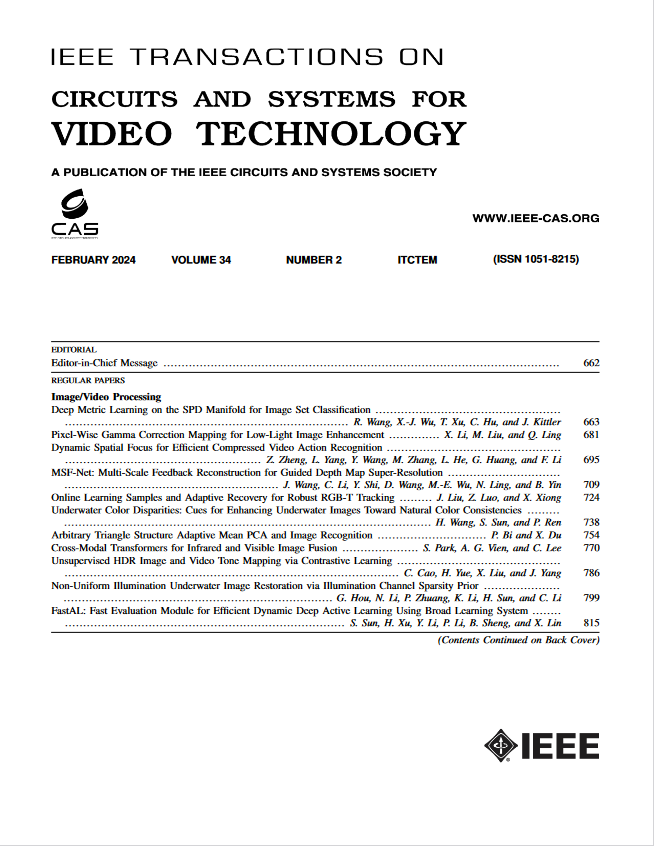深度终身跨模态哈希算法
IF 8.3
1区 工程技术
Q1 ENGINEERING, ELECTRICAL & ELECTRONIC
IEEE Transactions on Circuits and Systems for Video Technology
Pub Date : 2024-08-27
DOI:10.1109/TCSVT.2024.3450490
引用次数: 0
摘要
哈希方法以其快速的查询速度和较低的存储成本在跨模态检索任务中取得了重大进展。其中,基于深度学习的哈希算法由于对非线性异构特征具有出色的提取和表示能力,在大规模数据上取得了更好的性能。然而,当具有新类别的数据连续到达时,灾难性遗忘仍然存在两个主要挑战,以及非连续哈希检索重新训练更新所需的时间。为此,我们在本文中提出了一种新的深度终身跨模态哈希,以实现终身哈希检索,而不是在新数据到达时重复训练哈希函数。具体而言,我们设计了终身学习策略,通过直接训练增量数据来更新哈希函数,而不是使用所有累积数据重新训练新的哈希函数,从而大大减少了训练时间。然后,我们提出终身哈希损失,使原始哈希码参与终身学习但保持不变,并进一步保持原始哈希码和增量哈希码之间的相似性和不相似性,以保持性能。此外,考虑到连续新数据到达时的分布异质性,我们引入了增强语义相似度来监督哈希学习,并通过详细的分析证明了相似度提高了性能。在基准数据集上的实验结果表明,与目前最先进的跨模态哈希方法相比,我们提出的方法取得了相当的性能,并且在连续出现新数据时,检索精度平均提高了20%以上,训练时间减少了80%以上。本文章由计算机程序翻译,如有差异,请以英文原文为准。
Deep Lifelong Cross-Modal Hashing
Hashing methods have made significant progress in cross-modal retrieval tasks with fast query speed and low storage cost. Among them, deep learning-based hashing achieves better performance on large-scale data due to its excellent extraction and representation ability for nonlinear heterogeneous features. However, there are still two main challenges in catastrophic forgetting when data with new categories arrive continuously, and time-consuming for non-continuous hashing retrieval to retrain for updating. To this end, we, in this paper, propose a novel deep lifelong cross-modal hashing to achieve lifelong hashing retrieval instead of re-training hash function repeatedly when new data arrive. Specifically, we design lifelong learning strategy to update hash functions by directly training the incremental data instead of retraining new hash functions using all the accumulated data, which significantly reduce training time. Then, we propose lifelong hashing loss to enable original hash codes participate in lifelong learning but remain invariant, and further preserve the similarity and dis-similarity among original and incremental hash codes to maintain performance. Additionally, considering distribution heterogeneity when new data arriving continuously, we introduce enhanced-semantic similarity to supervise hash learning, and it has been proven that the similarity improves performance with detailed analysis. Experimental results on benchmark datasets show that our proposed method achieves comparative performance comparing with recent state-of-the-art cross-modal hashing methods, and it yields substantial average increments over 20% in retrieval accuracy and almost reduces over 80% training time when new data arrives continuously.
求助全文
通过发布文献求助,成功后即可免费获取论文全文。
去求助
来源期刊
CiteScore
13.80
自引率
27.40%
发文量
660
审稿时长
5 months
期刊介绍:
The IEEE Transactions on Circuits and Systems for Video Technology (TCSVT) is dedicated to covering all aspects of video technologies from a circuits and systems perspective. We encourage submissions of general, theoretical, and application-oriented papers related to image and video acquisition, representation, presentation, and display. Additionally, we welcome contributions in areas such as processing, filtering, and transforms; analysis and synthesis; learning and understanding; compression, transmission, communication, and networking; as well as storage, retrieval, indexing, and search. Furthermore, papers focusing on hardware and software design and implementation are highly valued. Join us in advancing the field of video technology through innovative research and insights.

 求助内容:
求助内容: 应助结果提醒方式:
应助结果提醒方式:


